Impact of Irrigation Method on Water Use Efficiency and Productivity of Fodder Crops in Nepal
Abstract
:1. Introduction

2. Study Area and Methodology
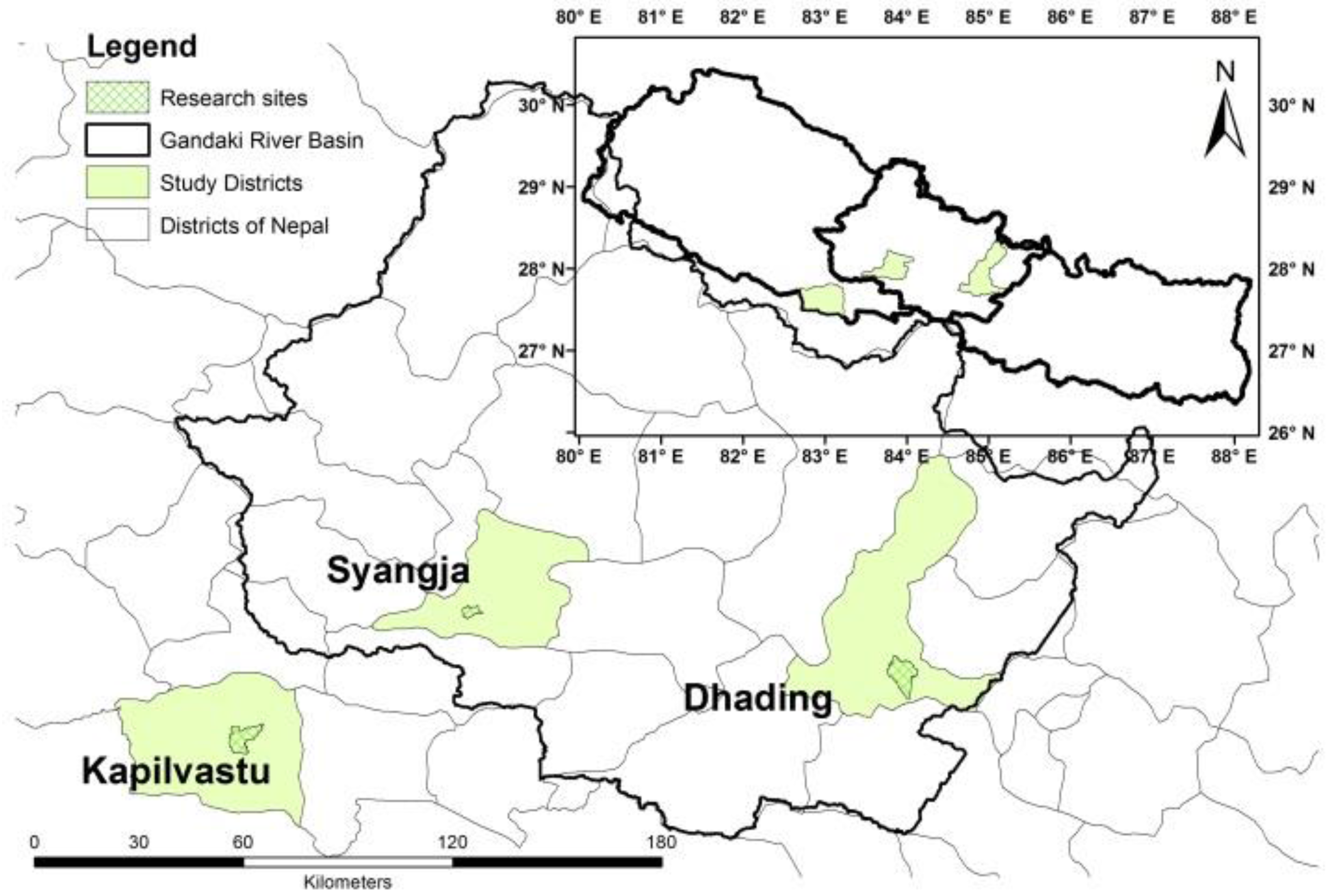
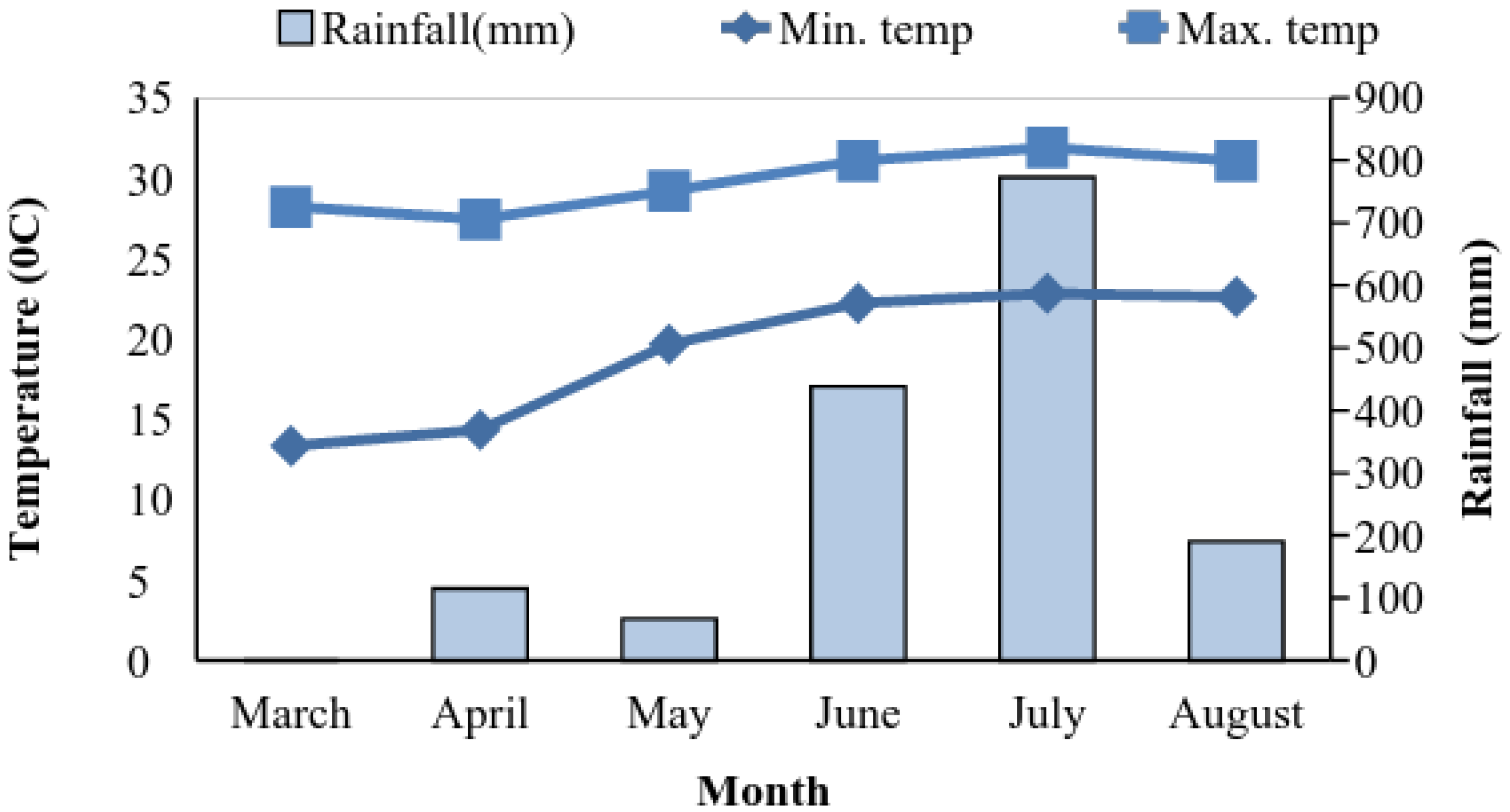
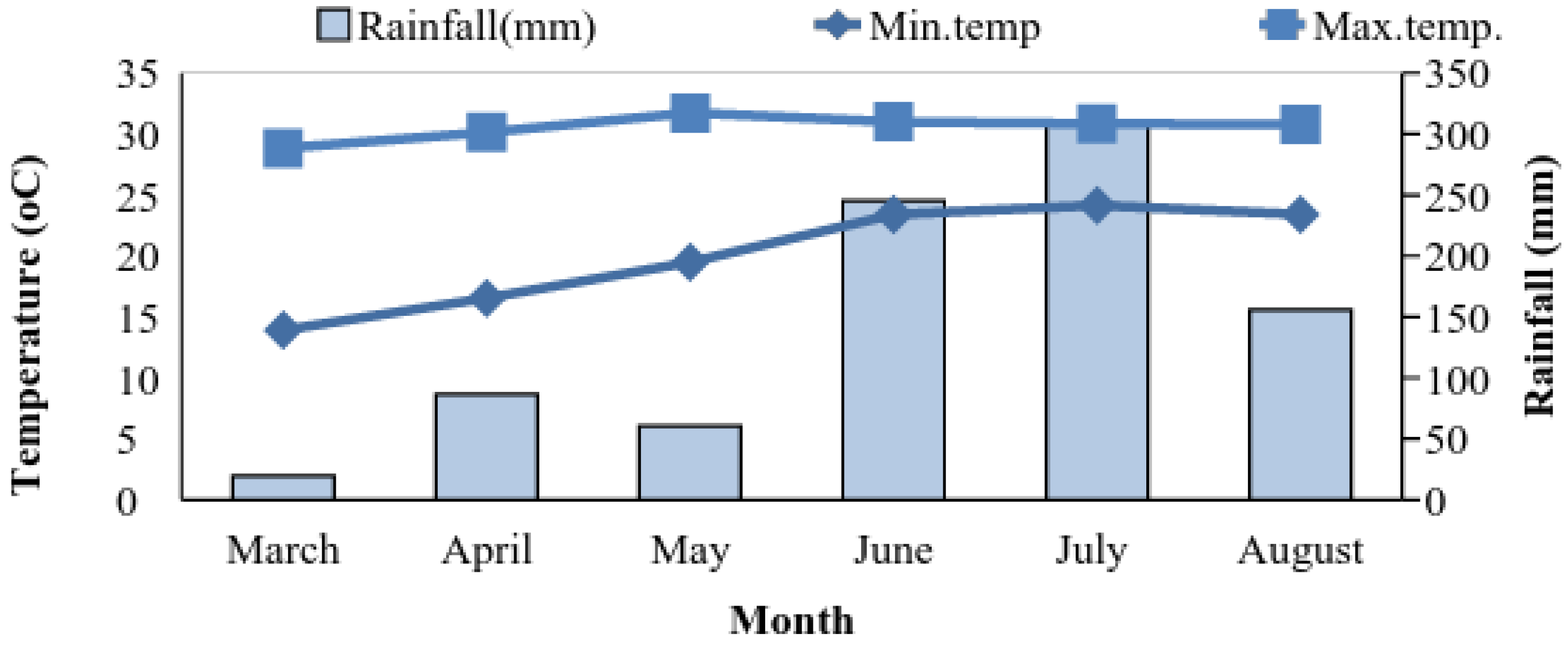
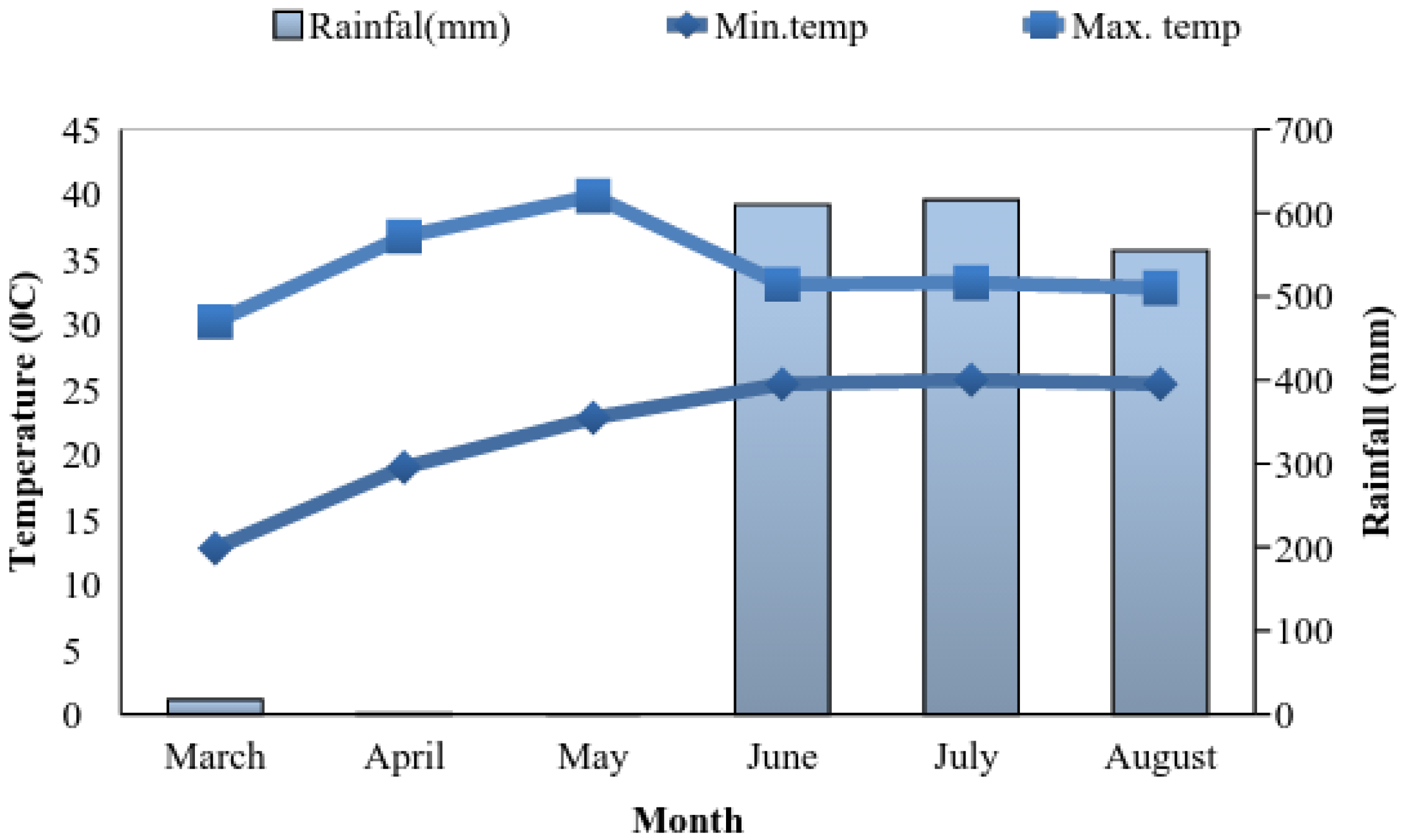
| Experimental Site | pH | OM (%) | Total N% | P2O5 (kgha−1) | K2O (kgha−1) | Sand (%) | FC (%) | PWP (%) | Silt (%) | Clay (%) | Text | BD (gcm−3) |
|---|---|---|---|---|---|---|---|---|---|---|---|---|
| Kapilvastu | 7.1 | 0.53 | 0.05 | 40.0 | 94.3 | 38.3 | 16 | 29 | 37.5 | 24.1 | L | 1.37 |
| Syangja | 6.9 | 0.77 | 0.06 | 42.5 | 176.5 | 42.5 | 12 | 24.6 | 38.0 | 19.4 | L | 1.41 |
| Dhading | 5.1 | 1.2 | 0.07 | 7.5 | 103.4 | 49.0 | 13.3 | 25 | 29.5 | 21.4 | L | 1.41 |
3. Results and Discussion
3.1. Dry Matter Yield
| Interaction | Total Nitrogen (%) | Available P2O5 (kgha−1) | Exchangeable K2O (kgha−1) | DM Production (kgha−1) |
|---|---|---|---|---|
| Kapilvastu*Cowpea | 0.068 | 93.179 | 89.519 | 2410 cd |
| Kapilvastu*Cowpea/Teosinte | 0.074 | 87.794 | 91.509 | 2844 cd |
| Kapilvastu*Teosinte | 0.068 | 86.604 | 90.845 | 3773 c |
| Syangja*Cowpea | 0.074 | 103.864 | 176.651 | 2249 cd |
| Syangja*Cowpea/Teosinte | 0.073 | 95.223 | 176.524 | 9142 a |
| Syangja*Teosinte | 0.073 | 94.806 | 174.984 | 9435 a |
| Dhading*Cowpea | 0.088 | 17.407 | 114.729 | 1195 d |
| Dhading*Cowpea/Teosinte | 0.084 | 15.156 | 112.179 | 6360 b |
| Dhading*Teosinte | 0.095 | 16.105 | 113.299 | 9397 a |
| LSD | Ns | Ns | Ns | 1831 ** |
| SEm± | 0.0028 | 0.325 | 1.180 | 638 |
| CV% | 10.28% | 1.36% | 2.63% | 24.72% |
| Grand mean | 0.07 | 67.79 | 126.93 | 5200 |
3.2. Green Biomass Yield
| Location | Green Biomass Production (kgm−2) | |
|---|---|---|
| Teosinte | Cowpea | |
| Kapilvastu | 9.169b | 5.098a |
| Syangja | 8.449ab | 4.591ab |
| Dhading | 7.511b | 4.099b |
| Irrigation | Green Biomass Production (kgm−2) | |
|---|---|---|
| Teosinte | Cowpea | |
| Furrow | 8.809a | 4.978a |
| Drip | 7.943b | 4.213b |
3.3. Irrigation Water Consumption
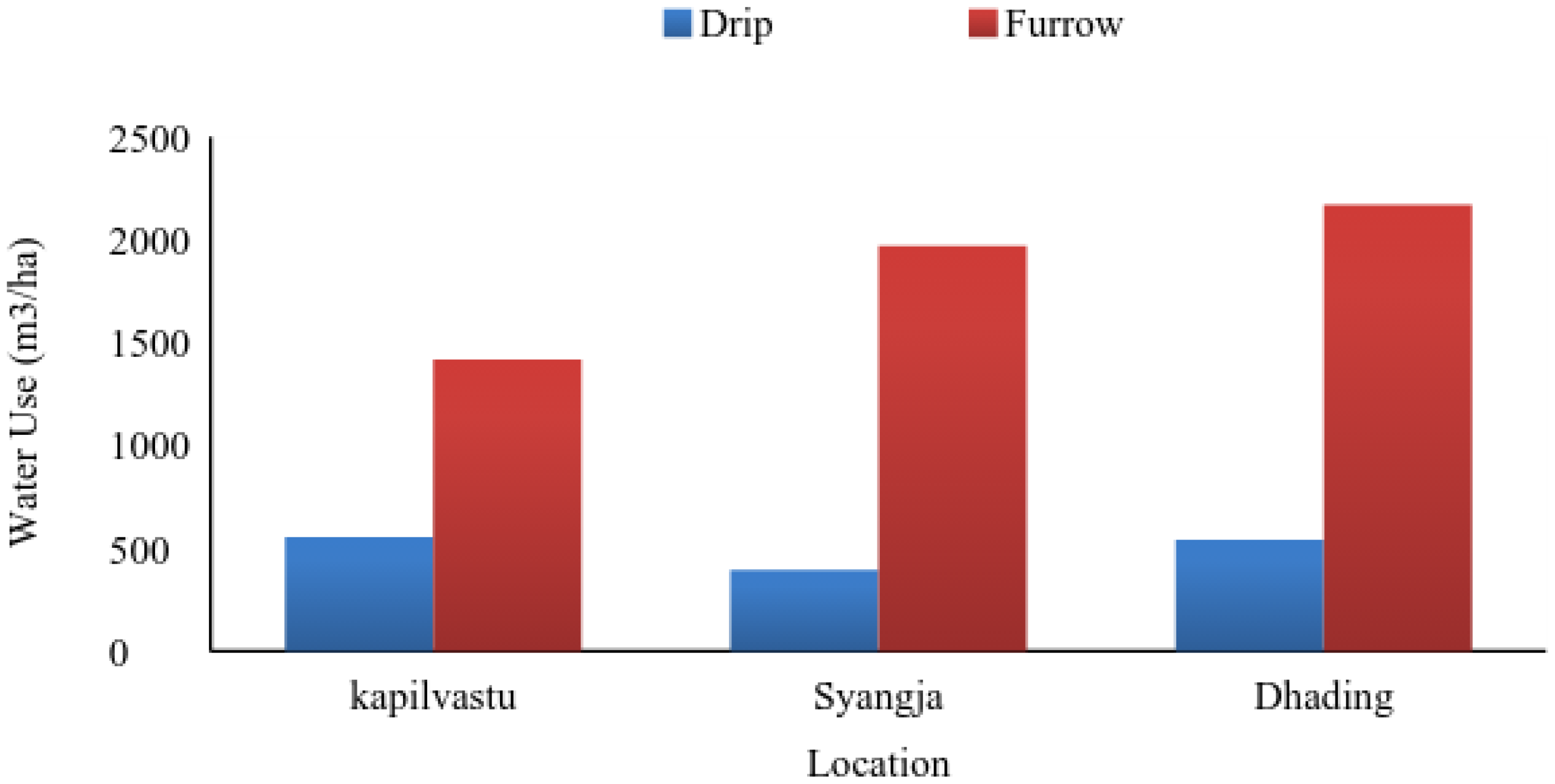
3.3.1. Combined Forage Dry Matter Yield
3.3.2. Yield and Irrigation Water Use Efficiency
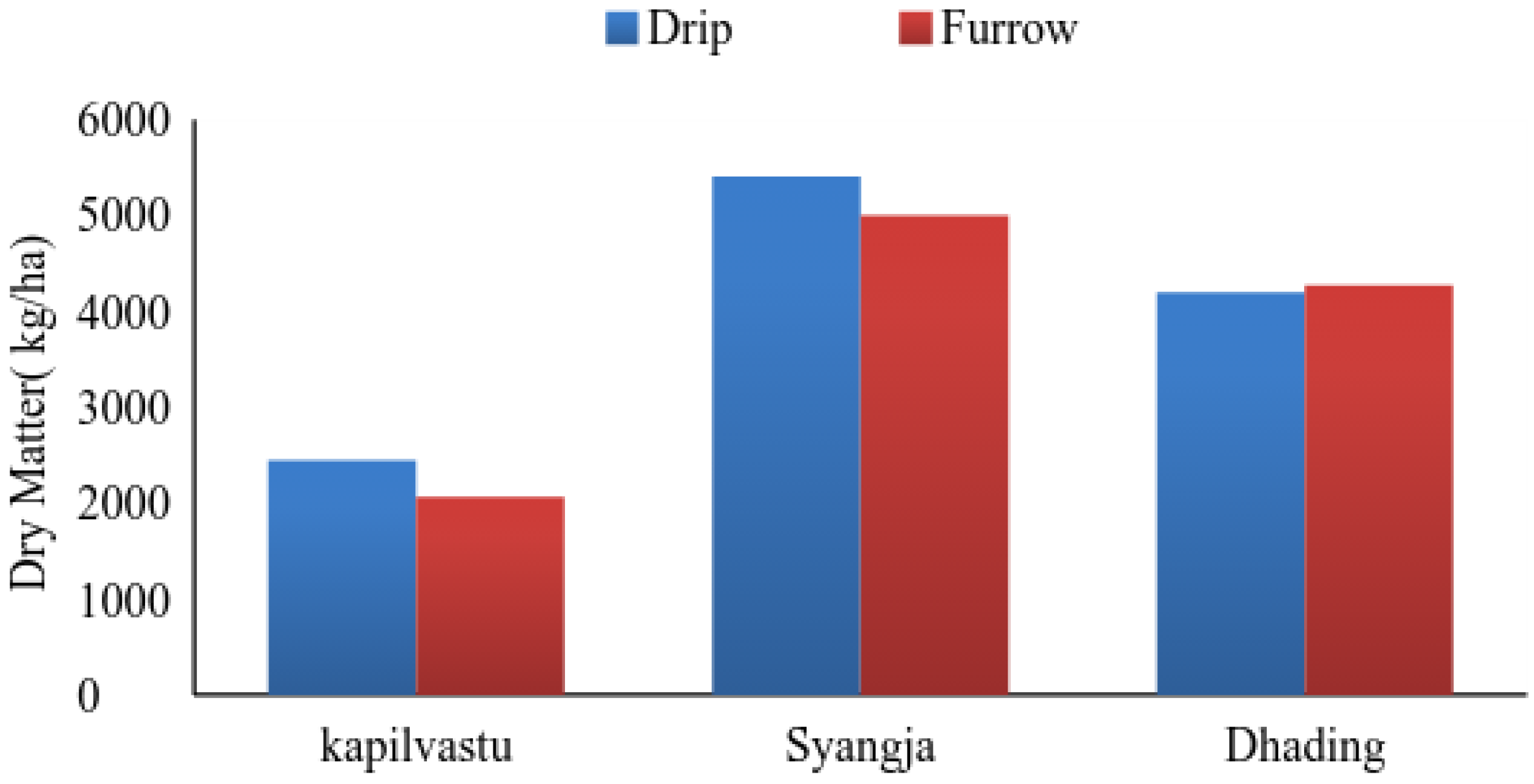
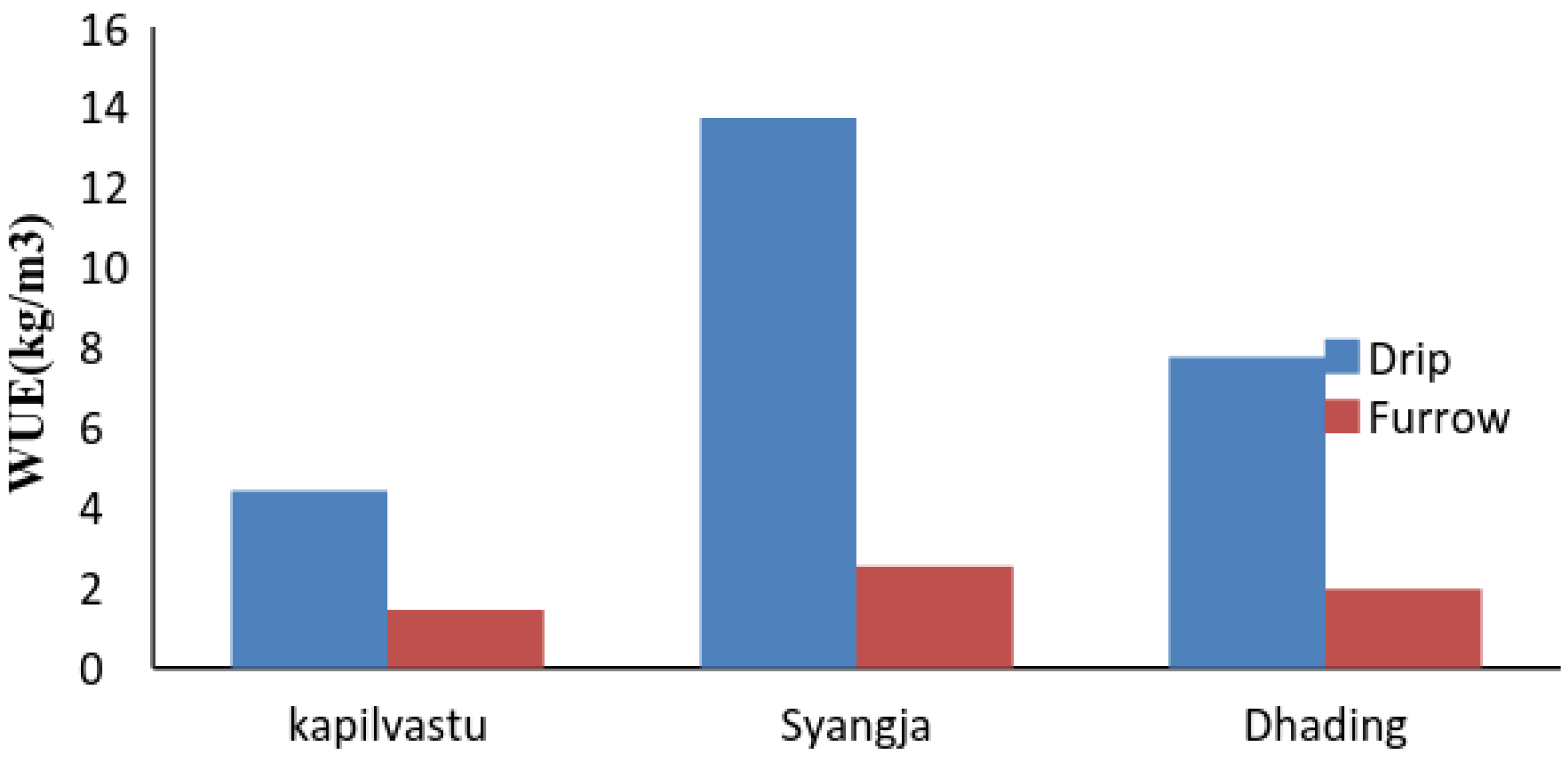
| Uniformity Coefficient (CU) | Distribution Uniformity (DU) | Application Efficiency (AE) | |
|---|---|---|---|
| Kapilvastu | 76.80 | 88.79 | 74.45 |
| Syangja | 83.43 | 89.23 | 76.05 |
| Dhading | 60.25 | 91.32 | 73.75 |
3.4. Soil Nutrients
3.4.1. Effect of Irrigation Type and Cropping Pattern on Soil Nitrogen
| Treatments | Total Nitrogen (%) | Available P2O5 (kgha−1) | Exchangeable K2O (kgha−1) | DM Production (kgha−1) |
|---|---|---|---|---|
| Locations | ||||
| Kapilvastu | 0.070 c | 89.19 b | 90.62 c | 3009 c |
| Syangja | 0.073 b | 97.96 a | 176.05 a | 6942 a |
| Dhading | 0.080 a | 16.22 c | 113.40 b | 5651 b |
| LSD | 0.00065 ** | 0.52 ** | 1.07 ** | 928 ** |
| SEm± | 0.0013 | 0.16 | 0.33 | 290 |
| Irrigation Methods | ||||
| Furrow | 0.08 a | 67.58 | 126.27 | 5041 |
| Drip | 0.07 b | 68.00 | 127.11 | 5360 |
| LSD | 0.00053 | NS | NS | NS |
| SEm± | 0.0011 | 0.13 | 0.27 | 580 |
| Cropping system | ||||
| Cowpea | 0.07 | 71.48 a | 126.96 | 1951 c |
| Cowpea + Teosinte | 0.07 | 66.05 b | 126.73 | 6115 b |
| Teosinte | 0.07 | 65.83 b | 126.37 | 7535 a |
| LSD | NS | 0.53 ** | NS | 1057 ** |
| SEm± | 0.0016 | 0.18 | 0.68 | 368 |
| CV% | 10.28% | 1.36% | 2.63% | 24.72% |
| Grand mean | 0.07 | 67.79 | 126.93 | 5200 |
3.4.2. Effect of Irrigation Type and Cropping Pattern on Soil Available Phosphorus
3.4.3. Effect of Irrigation Type and Cropping Pattern on Soil Exchangeable Potassium
4. Conclusions
Acknowledgments
Author Contributions
Conflicts of Interest
References
- Kurukulasuriya, P.; Rosenthal, S. Climate Change and Agriculture: A Review of Impacts and Adaptations; The World Bank: Washington, DC, USA, 2003. [Google Scholar]
- IPCC. Summary for policymakers. In Climate Change 2007: Impacts, Adaptation and Vulnerability; Parry, M.L., Canziani, O.F., Palutikof, J.P., van der Linden, P.J., Hanson, C.E., Eds.; Cambridge University Press: Cambridge, UK, 2007; pp. 7–22. [Google Scholar]
- Thornton, P.; van de Steeg, J.; Notenbaert, A.; Herrero, M. The impacts of climate change on livestock and livestock systems in developing countries: A review of what we know and what we need to know. Agric. Syst. 2009, 101, 113–127. [Google Scholar] [CrossRef]
- Pradhanang, U.B.; Pradhanang, S.M.; Sthapit, A.; Krakauer, N.Y.; Jha, A.; Lakhankar, T. National livestock policy of Nepal: Needs and opportunities. Agriculture 2015, 5, 103–131. [Google Scholar] [CrossRef]
- Ministry of Agricultural Development (MOAD). Statistical Information on Nepalese Agriculture; Ministry of Agricultural Development (MOAD): Kathmandu, Nepal, 2012. [Google Scholar]
- Krakauer, N.Y.; Pradhanang, S.M.; Panthi, J.; Lakhankar, T.; Jha, A.K. Probabilistic precipitation estimation with a satellite product. Climate 2015, 3, 329–348. [Google Scholar] [CrossRef]
- Panthi, J.; Dahal, P.; Shrestha, M.L.; Aryal, S.; Krakauer, N.Y.; Pradhanang, S.M.; Lakhankar, T.; Jha, A.K.; Sharma, M.; Karki, R. Spatial and temporal variability of rainfall in the Gandaki River Basin of Nepal Himalaya. Climate 2015, 3, 210–226. [Google Scholar] [CrossRef]
- Krakauer, N.Y.; Pradhanang, S.M.; Panthi, J.; Lakhankar, T.; Jha, A.K. Evaluating satellite products for precipitation estimation in mountain regions: A case study for Nepal. Remote Sens. 2013, 5, 4107–4123. [Google Scholar] [CrossRef]
- Wang, S.; Jin-Ho, Y.; Gillies, R.; Cho, C. What caused the winter drought in western Nepal during recent years? J. Clim. 2013, 26, 8241–8256. [Google Scholar] [CrossRef]
- Sigdel, M.; Ikeda, M. Spatial and temporal analysis of drought in Nepal using standardized precipitation index and its relationship with climate indices. J. Hydrol. Meteorol. 2010, 7, 59–74. [Google Scholar] [CrossRef]
- Department of livestock services. Ministry of Livestock Development. Government of Nepal. Available online: http://www.dls.gov.np/downloads.php?id=0 (accessed on 4 January 2015).
- Soussa, H.K. Effects of drip irrigation water amount on crop yield, productivity and efficiency of water use in desert regions in Egypt. Nile Basin Water Sci. Eng. J. 2010, 3, 96–109. [Google Scholar]
- Hansen, V.E.; Israelsen, O.; Stringham, G. Irrigation Principles and Practices, 4th ed.; John Wiley & Sons: New York, NY, USA, 1980; p. 417. [Google Scholar]
- Ishfaq, M. Water New Technology; Global Water Institute: Lahore, Pakistan, 2002. [Google Scholar]
- Bhattarai, S.P.; Midmore, D.J.; Pendergast, L. Yield, water-use efficiencies and root distribution of soybean, chickpea and pumpkin under different subsurface drip irrigation depths and oxygation treatments in vertisols. Irrig. Sci. 2008, 26, 439–450. [Google Scholar] [CrossRef]
- Michael, A.M. Irrigation: Theory and Practice, 2nd ed.; Vikas Publishing House PVT. Ltd: Delhi, India, 2008; p. 768. [Google Scholar]
- Tubiello, F.; van der Velde, M. Land and Water Use Options for Climate Change Adaptation and Mitigation in Agriculture; SOLAW Background Thematic Report—TR04A; GET-Carbon: New York, NY, USA, 2010. [Google Scholar]
- Jha, A.K.; Dave, W. Trilateral Afghanistan and Pakistan Irrigation and Soil Conservation; Afghanistan Ministry of Agriculture, Irrigation and Livestock (MAIL) and USDA-Foreign Agricultural Services: Kabul, Afghanistan, 2013. [Google Scholar]
- Sharma, B.R. Availability, status and development and opportunities for augmentation of groundwater resources in India. In Proceedings of ICAR-IWMI Policy Dialogue on Ground Water Management, Karnal, India, 6–7 November 2001; pp. 1–18.
- Manandhar, D.N. Climate and Crops of Nepal; Nepal Agricultural Research Council and Swiss Agency for Development and Cooperation: Kathmandu, Nepal, 1989. [Google Scholar]
- Locascio, S.J. Management of irrigation for vegetables: Past, present and future. HortTechnology 2005, 15, 482–485. [Google Scholar]
- Li, S.-X.; Wang, Z.-H.; Malhi, S.S.; Li, S.-Q.; Gao, Y.-J.; Tian, X.-H. Nutrient and water management effects on crop production, and nutrient and water use efficiency in dryland areas of China. In Advances in Agronomy; Donald, L.S., Ed.; Academic Press: Waltham, MA, USA, 2009; pp. 223–265. [Google Scholar]
- Song, H.-X.; Li, S.-X. Root function in nutrient uptake and soil water effect on NO3−-N and NH4+-N Migration. Agric. Sci. China 2006, 5, 377–383. [Google Scholar] [CrossRef]
- Yang, L.-J.; Zhang, Y.-L.; Li, F.-S.; Lemcoff, J.H. Soil phosphorus distribution as affected by irrigation methods in plastic film house. Pedosphere 2011, 21, 712–718. [Google Scholar] [CrossRef]
- Green, T.R.; Ahuja, L.R.; Benjamin, J.G. Advances and challenges in predicting agricultural management effects on soil hydraulic properties. Geoderma 2003, 116, 3–27. [Google Scholar] [CrossRef]
- Cameira, M.R.; Fernando, R.M.; Pereira, L.S. Soil macropore dynamics affected by tillage and irrigation for a silty loam alluvial soil in southern Portugal. Soil Tillage Res. 2003, 70, 131–140. [Google Scholar] [CrossRef]
- Balkcom, K.B.; Curtis, L.M. Effects of Subsurface Drip Irrigation on Chemical Soil Properties. Master’s Thesis, Auburn University, Auburn, AL, USA, 2009. [Google Scholar]
- Hebbar, S.S.; Ramachandrappa, B.K.; Nanjappa, H.V.; Prabhakar, M. Studies on NPK drip fertigation in field grown tomato (Lycopersicon esculentum Mill.). Eur. J. Agron. 2004, 21, 117–127. [Google Scholar] [CrossRef]
- De Wrachien, D.; Goli, M.B. Global warming effects on irrigation development and crop production: A world-wide view. Agric. Sci. 2015, 6, 734–747. [Google Scholar] [CrossRef]
© 2016 by the authors; licensee MDPI, Basel, Switzerland. This article is an open access article distributed under the terms and conditions of the Creative Commons by Attribution (CC-BY) license (http://creativecommons.org/licenses/by/4.0/).
Share and Cite
Jha, A.K.; Malla, R.; Sharma, M.; Panthi, J.; Lakhankar, T.; Krakauer, N.Y.; Pradhanang, S.M.; Dahal, P.; Shrestha, M.L. Impact of Irrigation Method on Water Use Efficiency and Productivity of Fodder Crops in Nepal. Climate 2016, 4, 4. https://doi.org/10.3390/cli4010004
Jha AK, Malla R, Sharma M, Panthi J, Lakhankar T, Krakauer NY, Pradhanang SM, Dahal P, Shrestha ML. Impact of Irrigation Method on Water Use Efficiency and Productivity of Fodder Crops in Nepal. Climate. 2016; 4(1):4. https://doi.org/10.3390/cli4010004
Chicago/Turabian StyleJha, Ajay K, Razan Malla, Mohan Sharma, Jeeban Panthi, Tarendra Lakhankar, Nir Y. Krakauer, Soni M. Pradhanang, Piyush Dahal, and Madan Lall Shrestha. 2016. "Impact of Irrigation Method on Water Use Efficiency and Productivity of Fodder Crops in Nepal" Climate 4, no. 1: 4. https://doi.org/10.3390/cli4010004
APA StyleJha, A. K., Malla, R., Sharma, M., Panthi, J., Lakhankar, T., Krakauer, N. Y., Pradhanang, S. M., Dahal, P., & Shrestha, M. L. (2016). Impact of Irrigation Method on Water Use Efficiency and Productivity of Fodder Crops in Nepal. Climate, 4(1), 4. https://doi.org/10.3390/cli4010004









